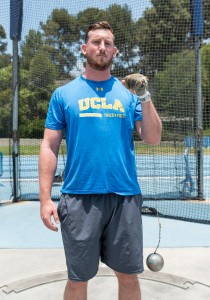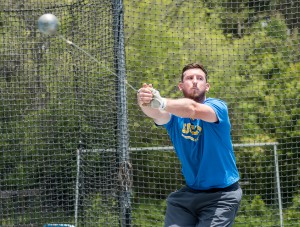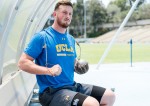When junior thrower Justin Stafford entered the weight room at Saddleback College on April 13, 2015, everything was going according to plan.
Stafford’s goal of making it to a Division I track and field program was coming to fruition. The day before, he had finished first among freshmen in the hammer throw and discus at the Mt. SAC Relays, the biggest meet of the year for junior college athletes.
One faulty platform put a halt to those plans.
That morning, Stafford began a workout he had performed countless times before, placing a barbell over his shoulders and stepping up and down onto a wooden box. On the last rep of his last set, Stafford lost his footing at the top and twisted his ankle.
The ankle injury by itself would not have posed a serious problem. However, Stafford still had a massive set of weights on top of him when his leg gave out.
“I just got bent in half, pretty much,” Stafford said. “It was a complete freak accident.”
Stafford thought he was fine at first, performing some basic stretches in the moments after the incident. However, once the adrenaline wore off, he realized he couldn’t walk.
Saddleback throws coach Shaun McGinley rushed Stafford to the hospital, where doctors found that the freshman had fractured his back. A second doctor told Stafford that he had also torn every muscle and ligament in the surrounding area.
Both doctors agreed that he would never throw again.
“It was a lot of shock, because I put all my efforts into succeeding at this sport,” Stafford said. “But then I was like, OK. Challenge accepted. Let’s do this … I was going to make this the best thing that ever happened to me.”
Just a few months before, Stafford arrived at Saddleback with one goal in mind: to leave.
“(Stafford) was in a real big hurry to get out,” McGinley said. “The minute he showed up, he had one foot out the door. The process was all about slowing him down so that he could really focus on what it was gonna take to get him to that next level, rather than jump the gun.”
With the emergency room doctor’s prognosis a few months later, Stafford’s throwing career did more than just slow down – it came to a dead stop.
Despite the prediction from the doctors that this injury marked the end of his career, Stafford was determined to return to the field one day and continue what he had started.
First, he would have to learn how to walk again.
“I had to use a walker for probably a month and a half,” Stafford said. “My nervous system was all messed up.”
In addition to the walker, Stafford’s recovery process also included six weeks of staying in a hospital bed in his living room, two months of wearing a back brace, and over nine months of physical therapy.
While McGinley could not assist his athlete physically during this time, he did his best to provide mental support.
“We constantly talked about the power of positivity and the healing capabilities of having a positive mindset,” McGinley said. “We knew that he had to be mentally stronger to get through what he needed to get through.”
Despite his immense physical limitations, Stafford continued his development as an athlete over the next year, deeply immersing himself in the sport.
“He would sit out at practice later on, figuring out what his next move was going to be,” McGinley said. “He had probably taken thousands of reps in his head over the course of that time.”
As Stafford continued to serve as a spectator at practices, he also took classes at Saddleback. All the while, his health steadily improved.
Little by little, Stafford found himself successfully performing activities he had struggled with the week before.
By April 2016 – approximately one year after being “bent in half” – Stafford’s back had fully healed.

Stafford did not miss a beat with his return. Neither the injury nor the time away from the sport had done anything to affect his form or ability. Before long, he was throwing even farther than he had prior to breaking his back.
However, there was not much time for Stafford to celebrate his comeback, as he then had to decide his next move. While the original plan was to compete for a second year at Saddleback, he discovered that he had taken too many class units and would be ruled ineligible if he stayed.
The plan shifted to what had been Stafford’s real focus all along: getting recruited by a Division I program. He spent summer 2016 working on his training, while also showcasing his talents to visiting coaches.
Stafford’s return to action caught the eye of UCLA throws coach John Frazier, who had been kept up to date with his progress throughout his injury.
“I had heard that he had broken his back, and his junior college coach had told me that he thought it was over,” Frazier said. “Months later, I heard from him again and he said ‘Hey, (Stafford) is doing well. We’ll see if he can make it back.’ Then, in the fall of 2016, I found out that (Stafford) was not only back from injury, but also throwing really well.”
Schools began to send Stafford offers that fall, including Washington and Arizona State. But for Stafford, there was one school that stood out from the rest.
“After the UCLA visit, I was like, ‘I would regret this for the rest of my life if I didn’t come here,’” Stafford said.
Stafford transferred to UCLA in fall 2016 and immediately began training with his new team. Early on, he found that there was an adjustment period to the new culture and the added pressure of being at a Division I school.
“No one really cares about what happened in the past,” Stafford said. “You’re just expected to produce.”
The following spring, Stafford took the field for the hammer throw at the UCLA Legends Invitational, his first time competing since his injury two years prior.

“It was the most amazing experience,” Stafford said. “Just awesome. Besides the fact that I fouled five out of my six throws.”
Stafford said his first year competing at UCLA was a “learning season.” He often struggled to stay in bounds, fouling half of his throws overall. This trend culminated at the NCAA West regional, where the sophomore fouled all three of his throws in the hammer, ending his season and missing out on a bid to nationals.
Since then, Stafford has hit his stride in his second year as a Bruin. He tallied six event victories and 11 top-three finishes during the 2018 regular season, and recently qualified for nationals for the first time in his career.
Stafford has also put his name in the school record book for the hammer throw. His personal best mark of 64.67 meters during the regular season placed him sixth all-time in UCLA history.
McGinley said that at least some of what we have seen from his former athlete this season can be attributed to that fateful moment in the Saddleback weight room three years ago.
“I think (Stafford) became an even stronger person for having the injury, and a lot of the success that he’s had since has been a result of the injury,” McGinley said. “I think that the best people always respond to that situation in a positive manner and can make it into an advantage.”
Today, Stafford says that he feels 100 percent, with no lingering health issues. However, he does still have some trouble when it comes to slowing down and keeping his excitement in check.
“The funniest thing about (Stafford) is that he’s so driven to be good that he’ll become impatient and try to finish my sentences while I’m talking to him,” Frazier said. “I blast him for that – you don’t even know what I’m going to say! But I understand why, because he wants to be good at everything he does.”
Now, Stafford is about to compete on the biggest stage that collegiate track and field has to offer, three years after what was supposed to be the end of his career.
“All the odds say that an average kid can’t make it to DI in any sport,” McGinley said. “I think the averages were against (Stafford) in the injury situation too. I don’t think (Stafford) ever acknowledges the odds.”
